Querétaro City (Santiago de Querétaro), Querétaro 作者: 来源: 发布时间:2021-05-27
1. Population and Area
Population: 625K+ Hab. (2010)
Metropolitan area: 1.1M Área: 759.9 km2
Querétaro State and City
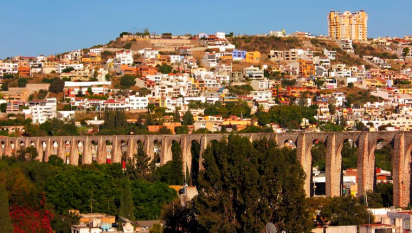
2. Natural geography
The municipality of Santiago de Querétaro is made up of plains, hills and mountains. The hills are made up of rounded hills that extend from south to north of the municipality.
The plain comprises alluvial sediments in the lower parts, slopes of sandstones and conglomerates and, in the higher parts, extrusive igneous rocks. This region starts at the town of the northern region called Ojo de Agua, and extends south through the towns of La Barreta, La Estacada, La Huerta, Casa Blanca, Santa Rosa Jáuregui, El Pie, Jurica, El Salitre, Santa María del Zapote, Tlacote, San Pedro Mártir and Peñuelas.
The height of this municipality varies from 1,900 to 2,150 meters above sea level. However, there are some higher elevations such as El Buey (2,210 masl), Pie de Gallo (2,340 masl), El Patol (2,460 masl), La Rochera (2,650 masl), El Pinalito (2,720 masl) and last but not least important, El Cerro del Cimatario (2,350 masl); the latter is really an extinct volcano and is very visible from the city of Santiago de Querétaro; therefore it is a point of reference from any part of the city.
The plain in the municipality develops in the city of Santiago de Querétaro and extends to the Northwest and Southwest with an altitude that varies from 1,800 to 1,900 meters above sea level.
Weather
The weather of Santiago de Querétaro is mild, but presenting very marked seasons: a winter with frequent frosts at night and little rainfall, a dry spring with stable temperatures, but with a hot and humid summer and a windy autumn that is often extreme. The rainy season (dry season) runs from April to September.
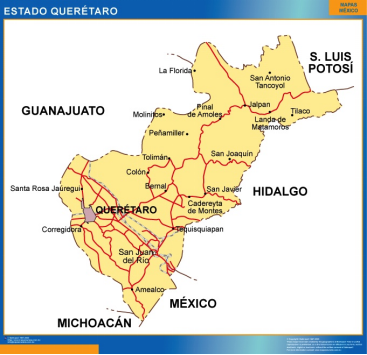
Getting there and around
By plane
Queretaro is served by Querétaro International Airport (QRO) which is a brand new international airport. There are direct daily flights to Monterrey, Cancun, and Tijuana in addition to Houston, Chicago-Midway, and Dallas-Fort Worth in the US. Domestic flights are expensive, so a bus may be more convenient (especially from Mexico City). A better option is to fly into Mexico City and then take a bus from there to Querétaro.
More info: http://www.aiq.com.mx/AEROLINEAS/indexa.html
By bus
There are many buses that go to Querétaro from major cities, such as Mexico City or Guadalajara. Buses are normally inexpensive and some bus lines offer student discounts in either official Mexican holidays or the summer, winter and April vacation period. Seniors over 65 get half price. First class buses often offer movies and can be very comfortable. In addition Queretaro also has frequent buses that run into the US (mainly Texas) usually operated by companies such as Autobuses Americanos or Turimex Internacional. The approximate travel time to the US will be around 22 hours.
The bus station is on the outskirts of the city, and features separate terminals for first-class bus lines and the local and regional second-class lines.
By car
There is toll road from Mexico City to Querétaro. It costs about 163 pesos for an automobile. The drive is about 2 hours, but add another hour for leaving/entering Mexico City.
You can also arrive easily from Leon (2hr) and the rest of Guanajuato state, San Luis Potosi (2hr) and Morelia (2hr).
Taxis will take you anywhere in town for a fare from $50 pesos up to $150 (to the airport $250) . Taxis do not have meters. Fares are established by the government and are determined by zone of pick up and zone of drop off.
People can also use apps such as Uber for transportation within the city, though new regulations forbid Uber drivers to pick up at the airport.
There are many privately operated buses on the main roads. You can buy a route book on any newspaper stand. The buses do not come into the historical center, but rather travel its boundaries on Zaragoza, Ezequiel Montes, Tecnologico, and Universidad.
The historical center of town is very compact. It's easy to walk around once you get there. There are also tour trolleys available. They start at the Plaza Corregidora.
3. Economy
By the beginning of 2011, it is estimated that the city of Santiago de Querétaro and the metropolitan area contribute 67% of the state's GDP, with a GDP of the city of $ 14,466,173,913.04 and a GDP per capita of $ 13,628.42 for which you can consider it a rich city in the Mexican standard that has an average GDP per capita of $ 10,170.35.36.
In 2010 the city presented an economic growth of 7.20% 36 much higher than the national growth of 4.2%.
4. Industry
Due to its privileged geographical location, Santiago de Querétaro has been a city with important commercial exchange since the 17th century, being located between Mexico City and the North of Mexico, the main activities of the city are industry, being one of the largest populations in Mexico: automotive, aeronautical, food, dairy, commerce, research and development, higher education, wine and vine production, glass and tourism.
Top 5 firms from Querétaro
·Fomento Queretano (Foque): Coca Cola bottling; milk and dairy, Super Q quick marts
·Desarrollos Residenciales Turísticos: high-end residencial developments
·Gas Express Nieto: natural gas distribution
·Grupo Dexel: mass media; tv, advertising and image consulting.
·Servicios Financieros Libertad: financial services; biggest popular investment service in Mexico.
Some important projects
Cultural development
After UNESCO named Querétaro as the Creative City of Design, the municipal president of Querétaro, Luis Bernardo Nava Guerrero, pointed out that this type of action will bring new projects focused on the consolidation of creativity as a strategic factor of sustainable urban development.
With this appointment, the Municipality joins a network of 246 cities that support its development in creativity through music, popular arts, design, cinema, literature, digital arts or gastronomy.
In consequence, Querétaro is developing 23 projects that will be presented to the United Nations Educational, Scientific and Cultural Organization (UNESCO), among which are: a Biennial, a design festival and the Center for Artisan Design and Innovation with the which is intended to promote the development of innovative products and link artisans with design professionals to promote local and international marketing of their products.
Industrial park expansión
Querétaro already is an industrial hub in the mid region of Mexico known as Bajío and has various very important industrial parks.
But after the effects generated by the Covid-19 pandemic, the industrial sector reports ups and downs, after the first semester of the year that represented a drop in productive activity and around the expectations of recovery that remains for this second semester.
However, added to this environment are some expansion projects that are still in force, despite economic uncertainty. In the El Marqués industrial park, four expansion projects for 180 million pesos are being developed, reported the director of Grupo Marqués -a firm specialized in the development of industrial parks-, Edmundo Díaz Sáenz.
The expansions are for companies related to the manufacture of auto parts and production for the medical sector.
The municipality of Querétaro City concentrates 39.3% of the industrial areas of the state.
5. Touristic sites
The entire central area of Queretaro City is full of landmarks and places to visit with historical relevance in Mexico’s political and cultural history. These are some of them:
El Cerrito archaeological zone
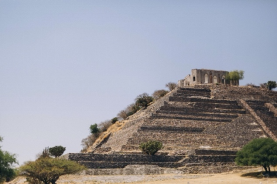
The archaeological zone of El cerrito is located 7 kilometers southwest of the historic center of the city of Querétaro, it is accessed by the Boulevard Constituyentes (formerly the free highway to Celaya), turning right at the Tejeda bridge, continuing along the street Hidalgo turning right is the main door.
This archaeological zone is located 7 km from the city of Querétaro. Its occupation was continuous from the Upper Preclassic to the 17th century. The architectural structures were built in a space of shallow soils with rocky outcrops, which were used for the construction of the bases and housing platforms. Archaeological evidence suggests that the site captured influences from different cultures over time: Chupícuaro, Teotihuacán, Toltecas, Chichimecas, Purépechas and Otomíes. Although since the Late Classic El Cerrito was a place that incorporated other minor settlements into its territory, it is towards the Early Post Classic that El Cerrito has its time of greatest importance as a regional center linked to the Toltec expansion. After this stage, the site maintained its importance as a place of worship among the local ethnic groups (Otomíes, Purépechas and Chichimecas). Franciscan sources indicate that towards 1632 the natives continued offering to the pre-Hispanic deities in the altars of the site.
Teatro de la República (Theater of the Republic)
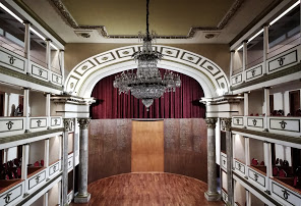
The Theater of the Republic is a building in the center of the city of Querétaro, a place of important historical events for Mexico, like the debut of the Mexican National Anthem or the debates that led to the drafting of the 1917 Mexican Constitution or the first Six Year Presidential Plan, in 1933.
Since the end of the nineties it has been the headquarters of the Queretaro Philharmonic Orchestra and of select cultural and political events. In 2008, several commemorative plaques were removed from its façade, making it more attractive.
On the first floor there is a small gallery with photos and writings of all the constituents. On the stage the states and their constituent deputies from 1917 are inscribed in gold letters.
On February 5 of each year there is an official ceremony for the anniversary of the Constitution; The President of Mexico, congressmen, governors and other high officials generally attend.
The Theater of the Republic is open to tourists from 10:00 a.m. m. at 2:00 p.m. m., Monday to Saturday, with free admission.
Casa de la Corregidora (Correctres’ House)
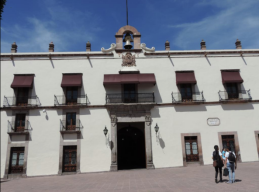
The Casa de la Corregidora is a building and historical Monument in the center of Santiago de Querétaro built in the 18th century, which was used as a Royal House and a prison. Since 1981, it has been the Government Palace of Querétaro, seat of the Executive Power of the State of Querétaro, Mexico. Originally it was the House of the Corregidores, the exact time in which it began to be called Casa de la Corregidora is unknown.
It is located on the north side of Plaza de Armas, on the corner of 5 de Mayo and Pasteur in the city of Santiago de Querétaro, a patrimony of humanity declared in 1996.
It is part of a UNESCO World Heritage Site, as it belongs to the Historic Monuments Zone of Querétaro.
Cerro de las campanas (Hill of the Bells)
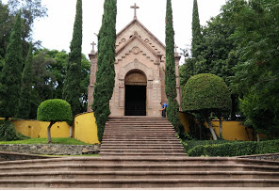
The Cerro de las Campanas is a hill located in the Ciudad Querétaro, State of Querétaro, in Mexico, it consists of an area of 58 hectares. This place has an important event in the history of Mexico, since Maximiliano de Habsburgo was captured here and shot together with his Generals Miguel Miramón and Tomas Mejía on June 19, 1867.
On May 15, 1967, a monument to Benito, the work of the sculptor Juan Francisco Olaguíbel, was inaugurated at the top, a colossal 13-meter-high sculpture of volcanic stone arranged on a pink quarry pedestal. Symbolically, Juárez would be on top of the monument erected in 1886 to Maximilian of Habsburg.
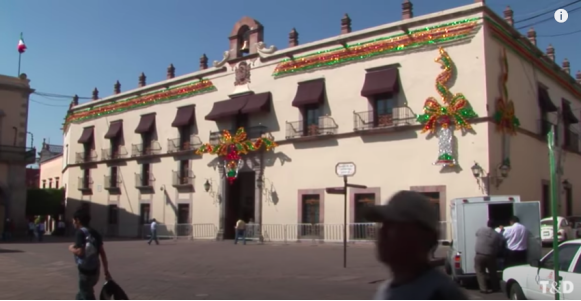
Querétaro Tourism Video: https://www.youtube.com/watch?v=5o81AJQJUwc
6. History and Culture
Foundation
The story goes that to achieve this foundation of the City, Spain requested the collaboration of the Spanish chief Hernán Pérez and the already Spanishized Otomí chief Nicolás de San Luis Montañez to convince Conín, an indigenous Otomí merchant who was going to this region to sell his products, to join to his cause and persuade the natives to be peacefully conquered.
Already baptized Conín as Fernando de Tapia, he carried out his task. However, in a concerted and unarmed manner, on July 25, 1531, on the Loma del Sangremal there was a battle between Christians and indigenous people who opposed the conquest. It was a long and bloody battle.
This is where the legend comes in. Supposedly, being very tired and almost defeated, the Spanish invoked the Patron of Spain, the Apostle Santiago. When it appeared in the sky, there was an eclipse that covered the sun completely. In the darkness, the natives observed a large luminous cross and the figure of the apostle Santiago riding his white steed. For the natives this was the sign of their defeat, their God had abandoned them. Instead, Christians received support from his. Thus ended the battle.
The city of Santiago de Querétaro was founded on the Loma del Sangremal.
Vice-royal time
Fray Junípero Serra as founder of the 5 missions of the Sierra Gorda de Querétaro: The Jalpan mission, Concá mission, Tancoyol mission, Tilaco mission and Landa de Matamoros mission.
The Spanish arrived on an uncertain date, around 1528. Hernán Pérez de Bocanegra y Córdoba allied himself with the Otomí Indian Conín, chief of Jilotepec, to peacefully conquer the new territories.
In 1531 the layout of the city of Querétaro was made by Juan Sánchez de Alaniz and by Conín, now baptized with a Castilian name: Don Fernando de Tapia.
Mexico's independence
In September 1810 Querétaro became the cradle of the Independence movement. On the 13th Epigmenio González was taken prisoner, who had an arsenal of weapons destined for the insurgency. On the 15th, the magistrate of Querétaro, Don Miguel Domínguez and his wife, Mrs. Josefa Ortiz de Domínguez, were arrested. Some historians affirm that she managed to send a message to Captain Ignacio Allende and Miguel Hidalgo, through Ignacio Pérez, a member of his militia who rode to San Miguel el Grande, today San Miguel de Allende to communicate to those who started the War of Independence from Mexico that the conspiracy had been discovered.
20th century
In 1916, the city was again named the capital of the country due to the Tampico Affair. In 1917, the Constitución Política de los Estados Unidos Mexicanos (Political Constitution of the United Mexican States) was promulgated by the Constituent Congress and president Venustiano Carranza.[3] This constitution still remains the law of the land.
7. Other information
Querétaro City has a population of about 10,000 foreign residents, coming from around 44 nations, which increases the cultural diversity of the city. There is an annual festival called the Festival of Foreign Communities. Among the most prominent communities are the Spanish, which is the second largest community in the state, after that of the US. 1,935 adult Spanish citizens reside in the state, according to statistics from the Spanish embassy in Mexico made in 2007, of which 75% live in the state capital. Other important communities are the German, Guatemalan, Italian, Russian, Argentine, Greek, Canadian, Colombian, French, Ukrainian, Croatian, Japanese, Salvadorean, Chinese, Lebanese, Korean, Polish, Chilean, Cuban and Peruvian.
The Festival of Santiago de Querétaro is an annual arts and cultural event that takes place in the city for eight days during Holy Week. It is sponsored by the city of Querétaro along with CONACULTA and the Secretary of Tourism for the state of Querétaro. Each year the event has a theme, which was being "Arte in Todos los Sentidos" (Art in All Senses) in 2009.The events are held in various locations, such as the City Museum, the Guerrero Garden, the Zenea Garden and the Rosalio Solano Theatre as well as the various plazas around the city center. The festival is held during Holy Week holiday to attract Mexican and international visitors to the city. The event starts with an inaugural parade through the streets of the historic center, starting from Corregidora Street to Constituyentes, Angela Peralta, Juárez, Madera, and Guerrero streets. The parade ends at the site where public officials open the event.
Over the eight days, both Mexican and international artists perform and exhibit their work. Events include music, painting, dance, photography, literature, special workshops and a children's pavilion. One final day, there is a culinary event were visitors can sample regional cuisine from restaurants of the city. The 2009 event has 110 events and with an expected attendance of about 3,150,000 people in total, far exceeding the 260,000 who attended in 2008. The 2009 event had concerts featuring traditional Mexican music, rock and jazz. Some of the international artists came from Italy, Argentina, and Brazil. Featured Mexican artists included Pindekuechua, a traditional music group from Morelia, Grupo Esparza from Guanajuato and Jazzcorps from Toluca.
8. Contact Information
City Mayor: Luis Nava
Citizen contact number: +52 (44) 2238 7770
Civic Center Address: Blvd. Bernardo Quintana 10000, Col. Centro Sur, Santiago de Querétaro, Qro. C.P. 76090, Mexico
Facebook: https://www.facebook.com/LuisBNava/
Twitter: https://twitter.com/luisbnava?lang=en
Whatsapp: +52 (44) 2507 0667
